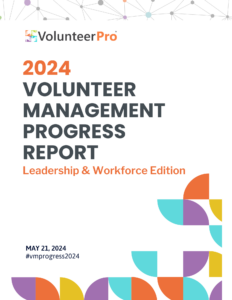 A Guide to Promoting Inclusive Volunteering: It’s About Power People
A Guide to Promoting Inclusive Volunteering: It’s About Power People
Last month, I began a conversation about promoting inclusive volunteering in this blog. I noted that, volunteerism can be a powerful vehicle for change. I believe that now, more than ever.
As leaders in the nonprofit space, we have a unique opportunity to break down barriers and help connect communities from all walks of life to engage in a shared purpose.
It’s a lofty goal, but it’s a challenge that many of VolunteerPro members have taken on. Active discussions and sharing around the creation of diversity, equity, and inclusion plans are taking place inside the community forum as members grapple with next steps in uncharted territory.
It’s a wonderful, but sobering and daunting enterprise. I applaud their courage and vision for a better world.
Like me, research reveals that the majority of leaders of volunteers in English-speaking countries are white (84%), educated women (87%). Setting aside misogyny, many of us are unaware of the true depths of our privilege and how it plays out across our interactions.
In today’s hectic, chaotic, and distracted world – fueled by systemic racism, insidious in its talent to infiltrate nearly every institution in society – it takes a determined person to stop, pay attention, and reach deep.
But, reach deep we must.
Because racism is happening right in front of our eyes, inside our organizations, and in how we lead volunteers.
And, while horrific acts of violence perpetrated against Black and Brown people are easy for many to recognize, often our own biases aren’t so evident, particularly if you are the unwitting beneficiary of a lifetime of white privilege.
I remember the very moment my own white entitlement come into full focus. I was on a road trip with two Black colleagues, and I will never forget it.
It was in the early 1990’s and I was in graduate school at the time. A native of the Pacific Northwest, living in the racially and ethnically divided Chicago was an eye-opener. All it took was a walk through the subway at rush hour to see segregation in action – whites to the left, heading north; Blacks to the right, heading south. Both sides heading home after a long day’s work.
On this trip, we were driving cross country from Chicago to New York City for an event our organization was hosting. As we made fast food stops along the freeway, I noticed hard stares from white people as we sat and ate quietly. I thought I was imagining things and kept silent.
On the morning of the second day, we drove from the hotel to a nearby pancake house. As we were exiting the car, my friends looked at one another and took a deep, singular breath in unison, as if gathering their courage. One asked the other, “Are you ready?”
I looked at them confused. Ready for what?
I had no clue. No clue that rural stretches of Indiana and Ohio felt dangerous to them. No clue that a mixed-race group travelling on its own could get into real trouble. No clue of what it might mean at all.
In spite of the fact that I spent much of my time in communities of color in Chicago, I remained oblivious to the totality of the experiences of my friends and colleagues. No clue.
As we entered the empty restaurant, we were led to a table. And there we sat. Without service, without acknowledgement from the white waitstaff.
After some time, it began to dawn on me. Discrimination in action. Discrimination I never saw. Discrimination that was so common for my friends that they could predict it before it even happened.
We sat quietly and after an eternity our orders were finally taken, our meals served.
For my peers, this was just another day of bearing the ignorance of others. For me, it became etched in my memory as a pivotal moment of clarity. I realized in that moment, that regardless of my intentions, my context, my personal activism, or my connections, I was blind when it came to the full extent of racial injustice.
It was a moment deeply instructional and humbling, even more so because 30 years later things haven’t changed.
Inclusive Volunteering: What Research Confirms
When it comes to promoting and championing inclusive volunteering, I believe we all need to become more attuned to what’s happening under our very noses and to pull back the curtain for a full examination.
Recently, my co-host Jennifer Bennett and I had the opportunity to interview Dr. Helen Timbrell, an organizational development consultant, and Hadji Singh, a volunteer and advocate, for Season 2 of the Time + Talent Podcast. The show will air this fall.
Hadji was part of a UK-based research study Helen conducted with white and BAME (Black, Asian, and minority ethnic) volunteers. I’m sad to say, I wasn’t surprised with some of the findings in the report and what Helen and Hadji shared. Here are only a few of the findings:
- BAME volunteers reported a range of micro-aggressions and racism when on duty from fellow volunteers, staff, and members of the public.
- In response to micro-aggressions and racism, some BAME volunteers felt they needed to work even harder to prove their worth.
- BAME volunteers felt they took up space that white volunteers appeared to feel belonged to them. Close-knit groups of older white women, in particular, made BAME volunteers feel unwelcome.
- The lack of ethnic diversity in the volunteer base, microaggressions, and racism was widely recognized but rarely discussed.
These results were a wake-up call.
It’s time to bear witness to what we’ve previously been blind to, or what we’ve simply allowed to occur for fear of making waves or simply discouraged by our own perceived lack of empowerment.
It’s time to get real about supporting volunteers of color. It’s time to take action. But, what does that look like?
(Note: If you’d like a free copy of the report “What the bloody hell are you doing here? A comparative study of the experiences of Black, Asian and Minority Ethnic and White volunteers in four organisations”, reach out to helen@helentimbrell.com.)
Inclusive Volunteering: Tough Questions to Ask
To foster truly inclusive volunteerism, we must look beyond simply diversifying our volunteer teams to ensure they “represent the communities they serve.”
Certainly, it’s a good first step, but without an overhaul in program design, I fear that the experiences of volunteers of color continue to be oppressive.
If we remain unaware of, or unable to admit to, the systematic racism within our own organizations, we are doomed to failure and to perpetrating harm, however unintended.
For me, the best place to seek answers are at the places where a power dynamic is in play. And, then to ask questions that can surface deep-rooted assumptions and habits.
Power is wielded mightily in the nonprofit sector, sometimes for the good, often at the expense of its own people. Foundations wield power over nonprofits, boards wield power over executives, supervisors over subordinates, paid staff over unpaid volunteers.
And yes, white over black and brown.
Here are a few questions to get you thinking from a volunteer’s perspective about whether they feel they are a valuable, respected, and included as a vital part of your organization’s work. These questions help unearth areas where power may need to be dismantled to offer a more equitable experience.
At your organization …
- Who defines and drives your organization’s approach to diversity, equity, and inclusion?
- Who is listed on the web page?
- Who is pictured on the web page and in publications?
- Who can speak on behalf of the organization?
- Who has access to which resources and budget?
- Who is included in which meetings, for both information and decision-making?
- Who leads meetings or agenda items?
- Whose schedules and limitations are of primary consideration when meetings, events, and trainings are planned?
- Who can make which decisions, and at what level?
- Who decides which decision-making process or style will be used (e.g. consensus, democratic vote, autocratic, etc.)?
- Who is consulted when changes are proposed or required?
- Who has access, and the ear of, key decision makers?
- Who gets to use what space and when, both physical and virtual?
- Who has their own dedicated space?
- Who can request special accommodations to address their access needs?
- Who is actively solicited for feedback?
- Who can see the aggregate data collected for feedback surveys, focus groups, comment cards, etc.?
- Who can bring up issues, at what time, and can they do so safely and without recrimination?
- Who is “allowed” to bring up issues around privilege, inequity, and discrimination?
- Who gets credit for successes?
- Who takes responsibility for failures?
- Who helps everyone keep their eye on the prize?
These are only a few questions that highlight what happens at many intersections of power.
If you’re ready to have tough conversations, and have prepared a safe space for meaningful conversations, these are a great place to start your journey.
Resources for Information and Inspiration
For other perspectives on how to promote diversity, equity, and inclusion in volunteerism, check out these helpful resources:
- John Lewis, Together, You Can Redeem the Soul of Our Nation – Published on the day of his funeral (July 30), the civil rights legend encourages us all to ” set aside race, class, age, language and nationality to demand respect for human dignity” in this moving final message.
- Teaching Tolerance, What Is White Privilege, Really? – Brought to use by the folks at the Southern Poverty Law Center, this essay helps unveil the unseen, unconscious advantages of race.
- Matthew R. Kay, Demystifying the “Safe Space”: How to Lead Meaningful Race Conversations in the Classroom – Talking about race is a necessary process for addressing inequity. Kay shares how to build conversational safe spaces, not merely declare them.
- Nonprofit HR, 2019 Nonprofit Diversity Practices Report – Learn about the diversity practices of over 550 social impact organizations which includes data, quotes, and stories for reflection.
- The Minnesota Association for Volunteerism (MAVA) Inclusive Volunteerism Initiative – This resource hub also includes a Racial Equity and Inclusion Resources for Volunteer Engagement Leaders list as well as the results of their 2017 study 8 Strategies for Creating a More Inclusive Volunteer Program.
- Tobi Johnson & Associates Blog, Nonprofit Leadership Best Practices: Advocating for Equity in Troubled Times – For a practical, step-by-step approach on how to deal with the inevitable resistance to change, check out this recent post.
The Courage to Dream … and Do
The current global discourse on racial equity makes this an exceptional time to speak truth to power in our sector. If you’ve worked against injustice in the past, current moment makes it more likely than ever leadership will heed your call.
So, have courage. Dig deep into the roots, ferret the causes, and cultivate a healthier, more level playing field for all.
No volunteer should have to “prove themselves” worthy of a place to serve. Just the opposite is true. Organizations should work diligently, humbly to become worthy of the tremendous volunteer talent that is bestowed upon them.
If they neglect the joys and treasures of a truly inclusive workplace, they are the ones that will be left behind as the rest of us move toward a better tomorrow, however imperfect the journey may be.
What is your organization doing to promote volunteer diversity, equity and inclusion? Share your initiatives in the comments below.








